NNDR Conference 2025: Part 2
This post is Part 2 of my trip to Helsinki for the Nordic Network on Disability Research (NNDR) Conference 2025. You’ll find Days 1–4 in my previous post.
Day 5
I started day 2 of the conference with Professor Nora Groce’s keynote titled Disability Research, Policy and Advocacy: How can we cause more trouble?. Prof. Groce is a key figure in disability studies and said that “good research should make a difference, and really good research should cause trouble.” She argued that disability researchers, policymakers, and practitioners should cause more “trouble” by more actively tackling global challenges.
As a researcher, progress can sometimes feel and actually be very slow. It can takes years to complete a project, and then more years to get it written up and published. And as just one person doing my PhD, it’s easy to question what the point of it is and whether it will actually make any difference, or if impact is just something we write into grant applications and journal articles because it’s the “right answer” (hint: it shouldn’t be).
A great piece of advice I received a few years ago is that if you want to do a PhD, you need to have a very good reason to do it, because at some point you’ll want to quit and you will need to that reason to be strong enough to keep going. I got into autism research kind of by chance, but it clicked immediately that it’s what I wanted to do, and so I’ve stuck with it. I believe in my work, I believe it’s important, and so I keep doing it. I’m now close to the end of the PhD (a little too close for comfort, if I’m honest!) and as I think about what I—as one person doing one project that feels miniscule and insignificant in the grand scheme of the universe—can do to cause more trouble, I think of it like recycling. One person’s efforts won’t change the world, but there is power in the collective. Multiply that by the ripple effect and a seemingly small action can have large, significant consequences.
But even without all that, I think also of memories. Everyone has that one memory from years ago that was a throwaway comment or tiny coincidence or casual action that has stuck with them ever since. Whether it was a compliment, running into someone that sparked a change in your life, or something that made you feel safe. Things that we think are tiny and inconsequential can often be the exact opposite, so why don’t we harness that power for good, both personally and professionally?
For me, as a researcher, that can mean something as simple and everyday as referring to the autistic people in my life using the terminology they prefer. It takes basically zero effort from me, but it communicates respect. I can also explain why this matters to those who aren’t familiar and encourage them to do the same. It’s a small way of making trouble, but inclusion can start small and then grow. As I build on the work of others before me, I hope that those who come after continue to do so, and one day we’ll look back and realise all the great trouble we caused.
Anyway, after those big thoughts and a quick coffee break, we headed straight into our first paper sessions of the day. They were held in the Main Building, and this time I was early enough to take in the design and snap some photos.
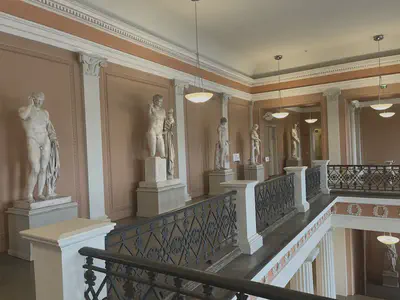
I stayed in the Neurodiversity stream for most of this conference (which is also where I bumped into a fellow autism researcher I’d met at ITAKOM), and listened to fantastic talks on how ADHD is represented in Finnish media (Anna Saurama), wellbeing in neurodivergent youth (Dr. Anne Kielland), coproducing mental health support with autistic university students (Ellie Horton and Dr. Anita Goldschmied), and the authenticity of autistic narratives in romance novels written by autistic authors (Veronika Vargova). There was, of course, time for lunch in between sessions, during which we also had a look at the posters on display.
I needed to rest my brain a little, so I went back to the hotel for a break before heading to Helsinki City Hall for the city reception. I met up with my supervisor, Emine, whom I’d run into occasionally throughout the conference, and the aforementioned autism researcher from ITAKOM. Even after 4 days of being in nice buildings, I wasn’t expecting this one to be so beautiful. And judging by everyone else’s reactions, neither were they!
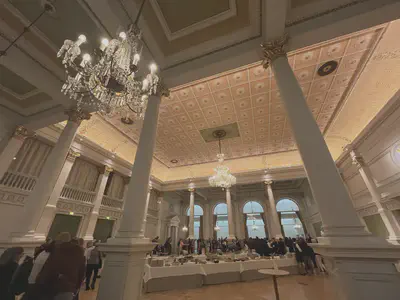
The reception was complimentary for us to attend, and the buffet (and wine) was great. There were very few tables and chairs, so we stood outside on the balcony and rested our wine glasses on the railing ledge (yes, I was afraid they would fall; no, they did not). The dinner ended relatively early at 8pm and we all headed back to our respective hotels to rest up for the final day of the conference.
Day 6
Friday was an early morning, with the first presentations beginning at 9am. We started off strong with Chetan Sastry Vijayakumar’s talk on neurodivergence, disclosure, and reasonable accommodations in Indian higher education. Being from Singapore, I’m always extra keen to hear about research being done in non-Western societies, and particularly in Asian ones.
And then it was time for my own presentation! I shared some findings from my second PhD study as well as preliminary findings from my third, which is still ongoing. I had rehearsed it so many times but of course still managed to overrun by a minute—thankfully there was more than enough time for all of us.
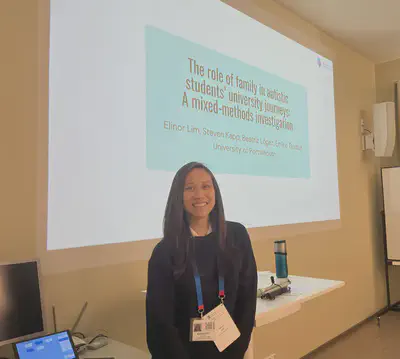
The session ended with Professors Nicola Martin and Lindsay O’Dell speaking about the inclusive doctoral journey and how the process as a whole can be made more accessible, particularly for neurodivergent students.
I had a quick lunch, and split the rest of the lunch break between the poster room and the sensory room. I hadn’t seen it before (or known where it was), but I wish I had! Through an evaluative lens, I thought it was done really well—completely dark except for the faint glow of natural light coming in from curtained windows and a couple of small fibre optic lights; no chairs, only assorted textures of beanbags, cushions, rugs, and just plain floor; noise-cancelling headphones; and various fidget/stim toys. There was also a set of polite rules on the door (e.g., please open and shut the door quietly as someone might be inside) for how to engage with the space. Experientially, I found it very welcoming. It provided a calm, quiet environment away from the busy chatter of the dining area down the hallway. In fact, it was so calming, I had to expend substantial effort to stay awake, lest I miss the next session!
Sensory rooms are becoming more common at disability- and neurodiversity-focused events, but loads more places could incorporate such a space, because it’s not just disabled/neurodivergent people who would benefit from having them available. I know only a handful of people who could spend every second of an event talking to others, but far more who would appreciate a few minutes to themselves.
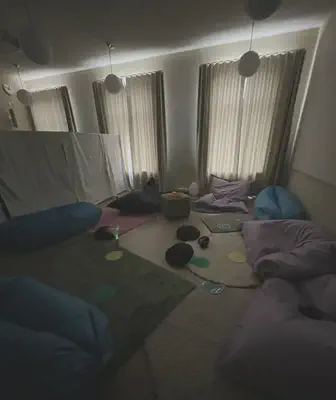
The talks I attended after lunch were also about inclusivity in higher education for neurodivergent/disabled students. My brain was going into low power mode by this point, so I headed to the nearby El Fant Cafe & Bar for some fuel (coffee, not alcohol). By chance, there was a Japanese-style cafe pop-up happening that day, and I was pleasantly surprised to find that they still had options available so late in the afternoon. I was torn between a matcha and hojicha almond(?) loaf slice and the barista recommended that the hojicha would pair well with the coffee I’d selected. I trusted their judgement, and they were right!
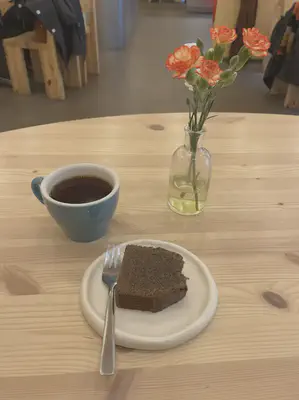
And then it was time for the closing keynotes and the end of the conference. The next event was the NNDR general assembly, which I skipped to return to the hotel and get some packing done to make future me’s life a little easier. I returned to the Main Building at 7pm for the conference dinner. There was champagne and opening remarks by the conference organisers, during which we were informed that the programme for the night included a dance and live music, both by disabled artists. Just like the conference lunches, this meal was also buffet-style, but with much more variety. I particularly enjoyed the live band, who played covers of popular songs in Finnish, and as I once again ate with non-Finns, we had fun trying to guess what the English version was. We were particularly proud of quickly we caught on to their rendition of “Let It Be” by The Beatles… until we realised they were singing in English.
The dinner ended at 10pm, though quite a few attendees had left by then. Many had early flights to catch the next day, but luckily I was not one of them. Still, after a long day (and week!) of big brain thoughts, I was ready to get some rest.
Day 7
I got up early for one last cafe run and took the tram to Kaffa Roastery. I tried a pourover of their Colombian gesha and grabbed a bag of those beans to take home too. On the way back to the hotel, I realised there was a bakery right next door to Kaffa that I hadn’t noticed before—Restaurant and Bakery Levain. Their viennoiserie was immensely tempting, but I managed to walk out with only 2 pastries.
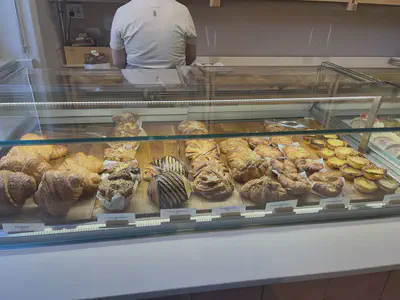
I got back to the hotel a little early, so I squeezed in a quick hotel breakfast before finishing up my packing. I had some time before I needed to check out and head to the airport, so it was time for pastry #1. I had the savoury pastry, which was filled with pesto, cheese, and sunflower seeds, and it was seriously good. Flaky, buttery, salty, and a mild tang from the pesto. I wished I’d discovered this bakery earlier, though it’s probably better for my health and my wallet that I hadn’t.
I checked out and headed to the airport. Once past security, the departure boards showing each flight’s gate number also had the direction and number of minutes away each respective gate was from that specific board. I’d never been in an airport that had that before and am now hoping this becomes a universal thing.
I saved pastry #2 for an in-flight snack. It was a korvapuusti—this time not sliced—and it was also delicious. I should have bought 2.
And just like that, it was time to say goodbye to Helsinki. I’m grateful to have had the opportunity to attend and present at NNDR 2025, and the privilege to explore the city outside of the conference. I had a great time, but I’m happy to be back in warmer England now, just in time for some sunny spring weather.
